 All Our Tours
All Our Tours
Written by: Vicky Nguyen
Updated date:26/09/2025
Contents
At Asia Viva Travel, we take pride in being a pioneer in ensuring the highest quality of our travel products and in maintaining a progressive spirit that constantly seeks to improve and innovate. As part of our commitment, we dedicate significant time each year to research and firsthand experience through multiple inspection trips, both large and small. These journeys allow us not only to evaluate services, routes, attractions, accommodations, and food options, but also to stay aligned with market demands so that every tour we design is built on authentic experience and genuine understanding.
In 2025, our most important inspection trip of the year has been dedicated to Ha Giang, a destination that has been steadily rising in popularity and is capturing the attention of travelers from around the world. Officially merged with Tuyen Quang Province in July 2025, the area now carries the new administrative name Tuyen Quang (formerly Ha Giang). This mountainous region in Northeast Vietnam is famed for its winding passes collectively known as the Ha Giang Loop, its majestic mountains, and rocky hillsides that bloom with vibrant flowers. Beyond its landscapes, Ha Giang is home to ethnic minority groups such as the H’Mong, Dao, and Tay, whose unique cultural identity sets this land apart, offering experiences that cannot be found elsewhere.
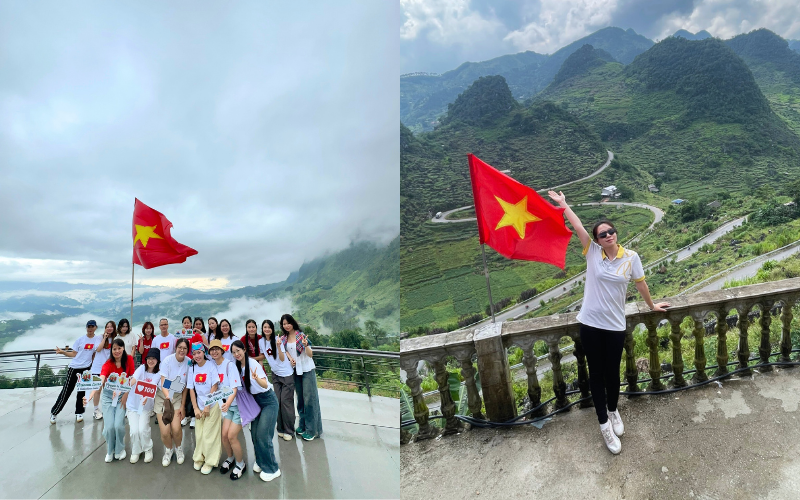
Inspection trip in Ha Giang
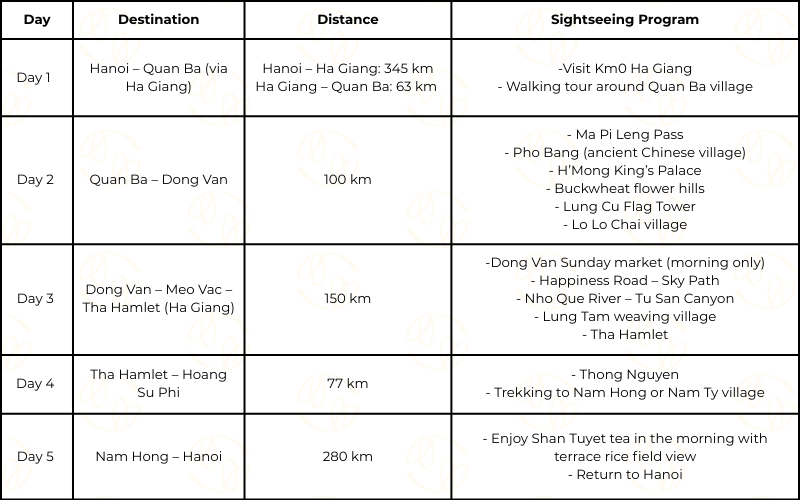
Ha Giang’s Itinerary in 5 days
With a distance of over 300 km from Hanoi, traveling to Ha Giang inevitably involves mountain passes and dirt roads. For this reason, starting the journey from Hanoi by car is the most practical and reliable option we chose.
Throughout the entire route, we observed that the Ha Giang region contains numerous winding passes, and in certain sections, landslides can occasionally affect road conditions. Therefore, for any itinerary in Ha Giang, it is highly recommended to engage local drivers and guides who are familiar with the terrain. This not only saves travel time but, more importantly, ensures safety on the road.
As Ha Giang is renowned for its breathtaking landscapes, travelers will often encounter scenic viewpoints along the way—such as panoramic bends overlooking mountain passes, or waterfalls cascading down the cliffs. In these cases, drivers or guides can arrange safe stops for photo opportunities, enhancing the overall travel experience.
Regarding transportation options, 4–7 seat cars and limousines are highly suitable for small groups. In this inspection trip, we traveled as a large group on a 29-seat coach, which navigated the roads smoothly without issue. Even for groups of up to 45 passengers, the journey remains possible thanks to the availability of transfer vehicles on narrower routes when necessary.
In addition, we noticed that many travelers prefer combining transportation methods: driving by car to Ha Giang City and then switching to motorbikes for mountainous stretches. This option allows for greater flexibility, closer contact with nature, and a more adventurous experience.
Note: For tourists who want to drive themselves to have a more authentic experience, they should pay attention to the roads near mountains and mountain passes to ensure safety. More importantly, please check your driver’s license carefully and the police here only accept valid international driver’s licenses.
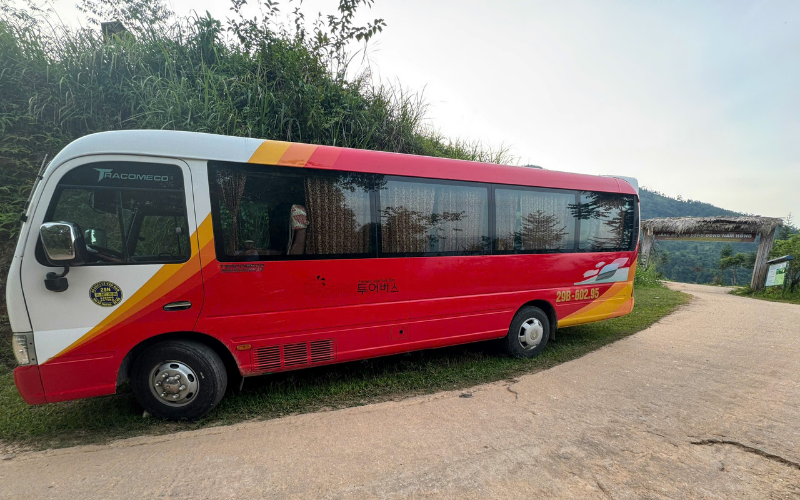
Transportation for Ha Giang trip
Based on the schedule, at each location we will choose a hotel/homestay and then also survey the surrounding accommodation locations to find other options. The list of accommodation locations below is also arranged according to the travel schedule.
On our first night, we stayed in a Dao ethnic village in Nam Dam Commune, where accommodations are designed as cozy wooden bungalows of varying sizes. The location is peaceful—set amid rice fields and close to a small waterfall—and the rooms, though without air-conditioning, stay comfortable thanks to the cool mountain climate. Private bathrooms are spacious and fully equipped, with extra blankets provided when needed.
The family-run homestay serves freshly prepared local meals and gives guests the chance to interact with the Dao community. It also offers traditional herbal treatments, such as foot soaks (available anytime) and full herbal baths (to be booked in advance), which we found refreshing and authentic. With its tranquil garden space for dining or bonfires, this homestay is a charming option for travelers seeking both comfort and cultural immersion.
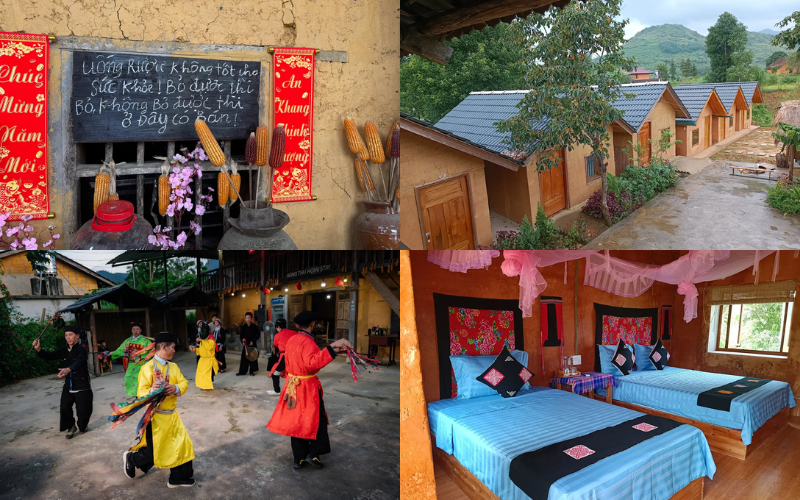
Hong Thu Homestay & Bungalow
In Dong Van, the atmosphere is busier as this is the central hub of Ha Giang’s northern region, attracting many travelers. Here, we stayed at Dong Van Ville H’Mong Hotel, located just a short distance from the Old Quarter.
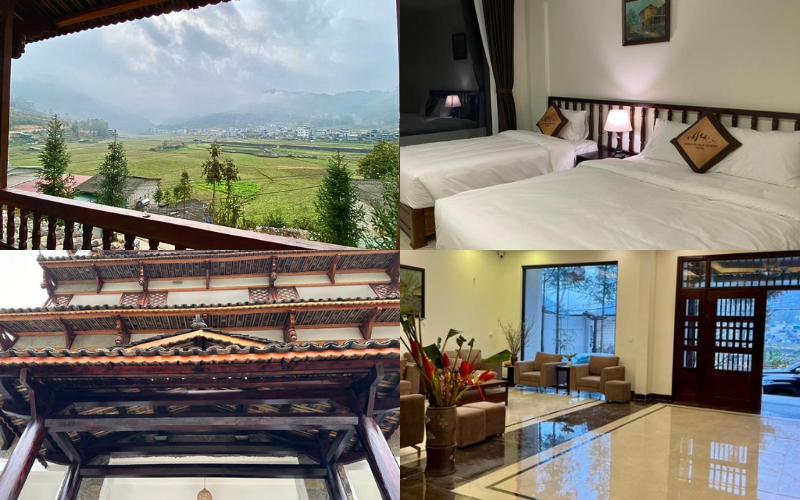
Dong Van Ville Du H’Mong Hotel
The hotel is spacious, with ample parking and friendly staff. Each room includes air-conditioning, a TV, and a private balcony—guests can choose between views of the town or rice fields. Rooms are bright and comfortable, though power outlets are limited and not always close to the bed. Bathrooms are small but well equipped, with essentials provided and even a hair dryer. Because of the location near rice fields and the hotel’s height, insects can appear; however, mosquito nets and protective screens are installed for convenience.
Additional services include laundry, motorbike rentals, and assistance with Ha Giang Loop bookings.
While the hotel is close to Dong Van Old Quarter, it requires a 5–10 minute walk. For travelers wanting to stay right next to the Old Quarter, we also surveyed several similar options nearby to provide more choices:
– Hoàng Ngọc Hotel ( Hoang Ngoc Hotel)
– Hoa Cương Hotel ( Hoa Cuong Hotel)
Located in Tha village, a peaceful Tay ethnic minority community just about 5 km from Ha Giang city center, we chose to stay at Mr. Cay Homestay.
The rooms here are built entirely of wood, each designed as a small private cabin. Inside, you will find solid wooden beds, air conditioning, and fully equipped bathrooms. Though the space is not very large, it feels warm and authentic.
Surrounding the homestay is a rustic landscape: a small swimming pool, an open courtyard, and lush rice fields stretching right beside the property, creating a fresh and tranquil atmosphere.
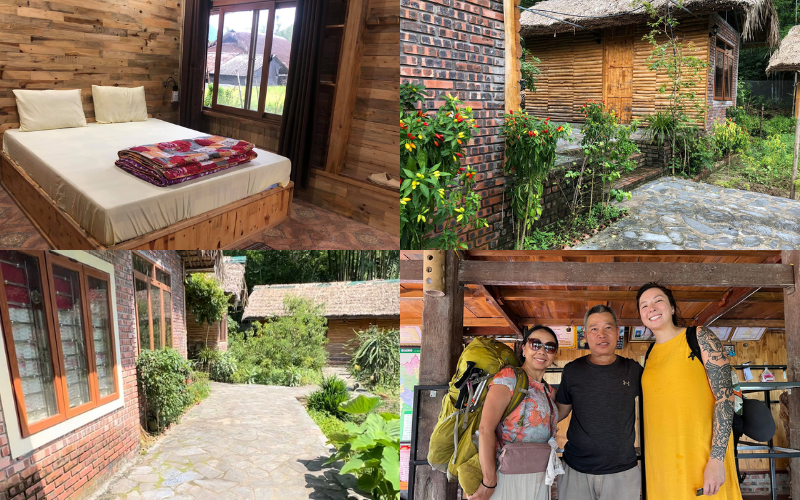
Mr. Cay Homestay – Tha village
Guests can enjoy a variety of relaxing activities such as trekking around the village, visiting nearby waterfalls for a refreshing swim, taking a dip in the homestay’s pool, or even spending the evening singing karaoke with friends.
One of the most memorable highlights is the opportunity to connect with Mr. Cay – the host, a war veteran. After a delicious homemade dinner, guests are invited to listen to his stories about past battles as well as the life and traditions of the Tay people. Adding to this unique cultural exchange, Mr. Cay once worked in Italy, which gave him a deep understanding of international guests’ tastes. Thanks to that, breakfasts at the homestay often feature a European touch, such as homemade crepes served with bananas freshly picked from the family’s garden.
This experience goes far beyond accommodation – it is an immersion into both history and culture, making every moment in Tha village unforgettable.
During our visit and stopover at Tha Village, we noticed that about 15 km away lies Xa Phin Commune, another very authentic village. It is an ideal spot for travelers who wish to go trekking and admire the terraced rice fields. Interestingly, the rice here is planted a bit later, which means the golden harvest season can last until late October and even early November.
Nestled among Hoang Su Phi’s iconic rice terraces, this community-based stay features bamboo and wooden bungalows with wide windows overlooking the fields. Rooms are simple but comfortable, equipped with basic amenities. There’s no air conditioning, yet the cool mountain nights make it pleasant.
The main house doubles as a reception and small restaurant; note that the bungalows are spread out, so assistance may require a short walk (a contact number is provided).
Facilities include a pool, outdoor tea area with Shan Tuyet tea – picked by the locals every morning , and the chance to try the Dao Red herbal bath or foot soak. Guests can also join the host for guided treks through villages, forests, and hilltops for sweeping views of the terraces.
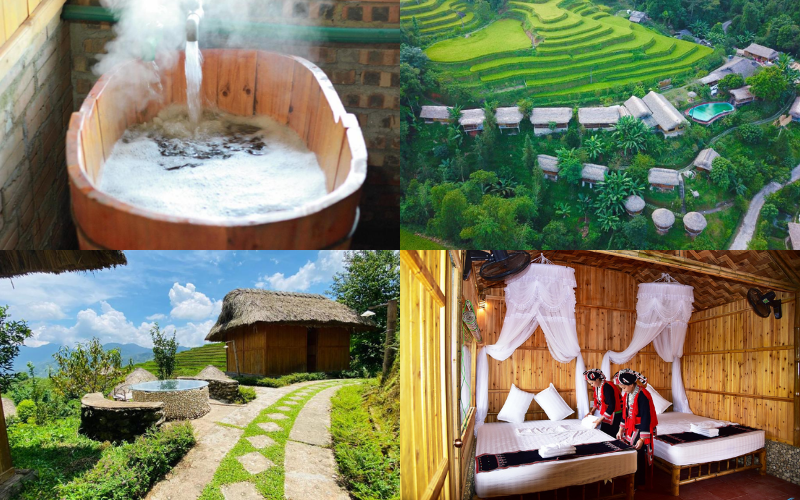
Hoang Su Phi Homestay
After surveying multiple properties, we noted several important points for travelers:
– Book early in peak season: The busiest times are March–May and especially mid-September to late October, when the rice terraces turn green and golden. To secure the best options, book accommodations well in advance—or reach out to Asia Viva Travel for assistance.
– Choose based on your needs: Ha Giang is a mountainous region where services can still be limited. Staying in community-based tourism villages or in areas closer to town centers will make transportation, dining, and shopping more convenient.
– Rely on local expertise: Don’t hesitate to connect with locals for authentic experiences—they know the terrain best. Avoid traveling entirely on your own to ensure safety and discover shorter routes to your desired destinations.
– Opt for places with dining services: Many homestays and hotels provide local meals. This allows you to enjoy specialties without the hassle of traveling far.
Ha Giang is gradually becoming more attractive to tourists, which gives the local people more motivation to develop tourism and promote their unique culture. However, to have the most authentic experiences, these suggestions and reviews are for the “iconic” places of Ha Giang:
To experience this authenticity, visitors are encouraged to explore the region’s ethnic minority villages through walking or trekking tours.
Home to 17 ethnic groups, each district, such as Quan Ba, Dong Van, and Meo Vac, offers distinct cultural landscapes. Villages range from simple farming communities to traditional craft hamlets, all providing intimate opportunities to connect with daily life in the mountains. Trekking trails often lead through rice terraces, fruit orchards, small forests, waterfalls, and tea plantations, creating both cultural and natural immersion.
One highly recommended stop is Lo Lo Chai Village in Dong Van, where nearly every home preserves the original Lo Lo architecture and decorative style. The village is charming yet compact, with yellow-painted houses, stone walls, and residents warmly welcoming guests in their colorful traditional attire.
Another highlight is Lung Tam weaving village, one of the few places where traditional brocade weaving continues to this day. The process of creating a handwoven fabric can involve up to 41 meticulous steps, all done by hand using simple tools. This craft is a point of deep pride for the local people, who remain committed to preserving and developing their heritage.
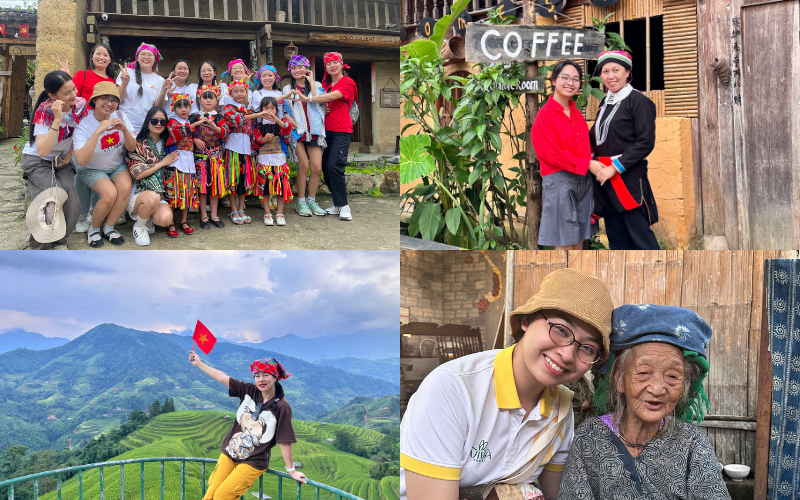
Trekking and Village Experiences in Ha Giang
Among the most iconic images of Ha Giang are the children dressed in vibrant traditional clothing, often carrying baskets of colorful flowers. At Ma Pi Leng Pass, famed for its winding curves carved between towering mountains—many visitors find themselves not only captivated by the breathtaking scenery but also touched by moments of connection with the local children. Travelers often stop to play traditional games such as shuttlecock kicking or tug-of-war, share laughter, or even let the children braid their hair and decorate it with fresh flowers. These spontaneous interactions create cherished memories and a deeper sense of cultural immersion.
It is important to note, however, that visitors are encouraged to engage respectfully: offering small gifts or snacks is welcomed, but giving money is discouraged, in line with local tourism authority guidelines. Always ask permission before taking photos.
For those seeking adventure, exploring Ma Pi Leng by motorbike is a popular choice. When arranged through reputable operators, it allows travelers to fully appreciate the grandeur of the mountains and valleys, with the wind rushing by and panoramic views unfolding at every turn. While the ride can be fast-paced and thrilling, it is best suited for those comfortable with mountain roads and eager for an adrenaline-filled experience.
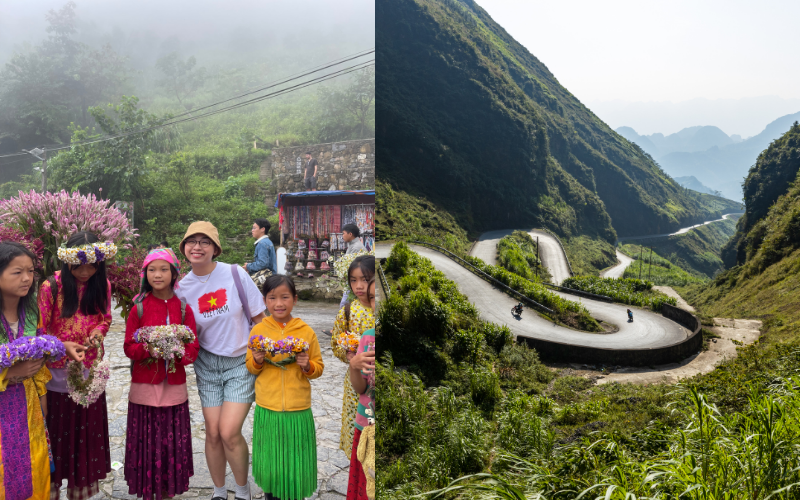
Ma Pi Leng Pass
Located at the very center of Ha Giang, Dong Van Old Quarter serves as both a cultural hub and a convenient base for exploring the surrounding highlands. Its lively atmosphere attracts countless visitors, with cobblestone streets lined by restaurants offering everything from authentic local specialties to Western-style dishes for those seeking familiar flavors.
What truly sets Dong Van apart, however, is its evening gatherings in the town square. Each night, and especially on weekends, the square comes alive with music, dancing, and the warm glow of a campfire. Locals and travelers join together, singing traditional songs, sharing laughter, and moving in circles around the fire—an atmosphere that feels both festive and intimate. This communal spirit makes Dong Van not just a place to stay, but a place to connect.
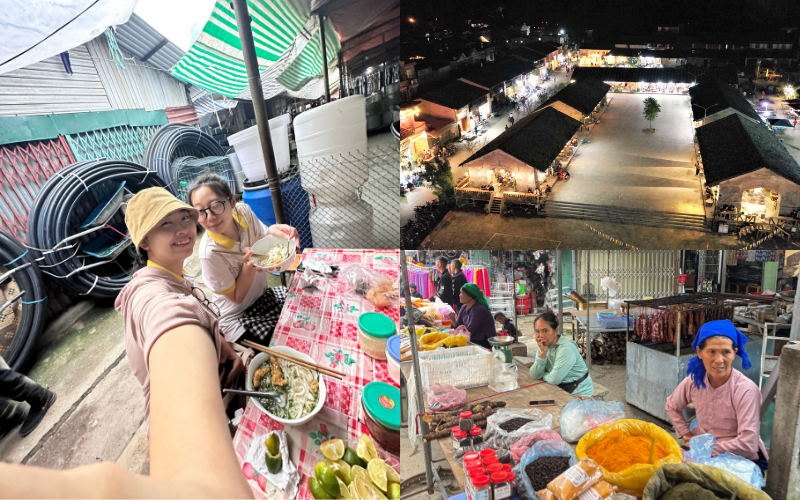
Dong Van market and Old Town
When it comes to iconic check-in spots in Hà Giang, two landmarks stand out:
Ha Giang Km0 – This milestone marks the official gateway into Hà Giang Province. Originally established before Hà Giang merged with Tuyên Quang, the marker was preserved to welcome travelers. From here, your adventure begins. Many visitors even purchase a “travel passport” to collect stamps, turning their experiences into a proud record of achievements.
Lung Cu Flag Tower – Known as the northernmost point of Vietnam, this site holds a Vietnamese flag measuring 54 square meters (about 581 square feet), proudly waving over the mountains. Standing here is not just a photo opportunity but also a moving reminder of cultural identity. This is also an awesome viewpoint since travelers have to step up over 800 steps to the tower, with the peak view from the tower, travelers might see the rice fields, mountains and villages.
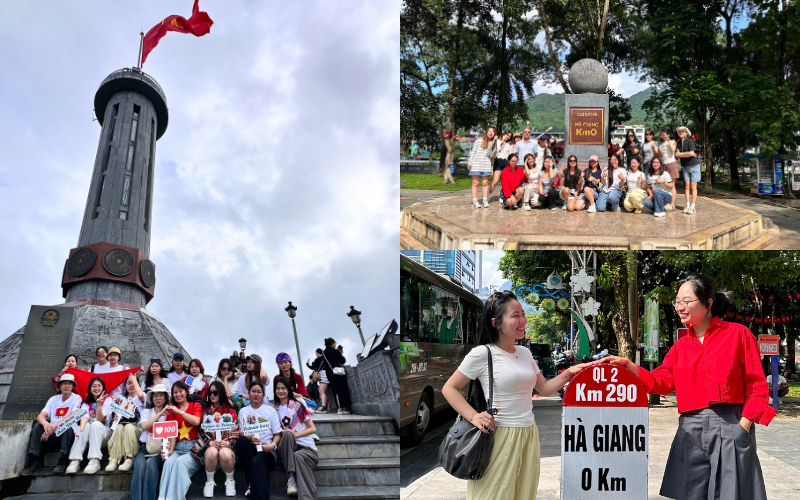
Ha Giang Km0 – Lung Cu Flag Tower
Beyond towering mountains and winding passes, Hà Giang also gives travelers the emerald ribbon of the Nho Que River. Flowing from China into Vietnam, the river carves its way through the dramatic Tu San Canyon – often called the deepest canyon in Southeast Asia.
Imagine gliding on a boat, the emerald water reflecting the sun’s rays breaking through drifting clouds, opening up a “pathway to heaven” framed by sheer limestone cliffs. This is the moment every visitor longs to capture. Along the way, the boat often stops at small resting points near a waterfall, where you can enjoy lunch, grab a cool drink, or take more photos.
Practical tips for your visit:
– You’ll need to purchase a ticket and take an electric car to reach the pier.
– All boats are equipped with life jackets to ensure safety.
– The boat trip lasts about 1–1.5 hours, a short yet unforgettable journey.
– Be mindful that the river has little shade — bring a hat or cap to avoid the midday heat.
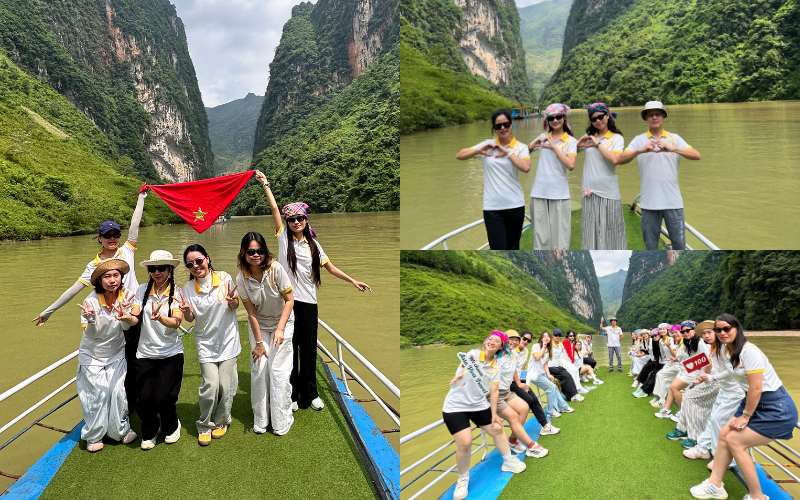
Nho Que River – Tu San Canyo
For travelers curious about the cultural legacy of the H’mong people, the H’mong King’s Palace (Dinh Vua Mèo) in Đồng Văn is a must-see. This residence once belonged to the powerful Vương family, who were among the wealthiest H’mong clans in the region. Beyond its grandeur, the palace also carries historical significance, as the family played a notable role during Vietnam’s revolutionary period.
Step inside and you’ll notice the striking blend of Chinese, French, and H’mong architecture — stone walls, wooden beams, and intricate carvings that reflect both power and cultural pride. The mansion stands as a rare glimpse into how a wealthy H’mong household lived a century ago, offering a sharp contrast to the modest life of most highland communities.
A practical tip: it’s highly recommended to arrange for an English-speaking guide in advance (Book for a whole Ha Giang trip would be highly recommended), as on-site guides usually only speak Vietnamese. This way, you won’t miss out on the many fascinating stories and legends tied to this historic home.
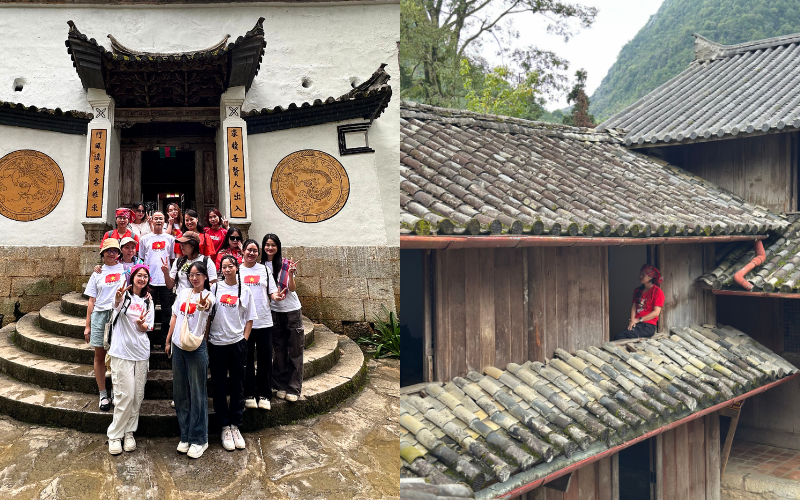
H’mong King’s Palace
What makes Ha Giang unforgettable is not only its breathtaking landscapes but also the warm hospitality of its people. Visitors are often invited to take part in daily activities such as climbing hills to pick tea leaves, planting rice, or grinding grains, turning a simple day into a memorable cultural exchange.
If you’re lucky, you might even witness or join in on a traditional festival. Each ethnic group in Hà Giang has its own rituals and celebrations, meaning every encounter holds the potential for a completely unique, “secret” experience that few travelers get to enjoy.
Food is another highlight that makes Hà Giang unforgettable. Northwest cuisine is shaped by its mountains: fresh organic vegetables grown only in highlands, and special local meats like black chicken or black pork, all raised naturally by ethnic families. The flavors here are rustic yet full of character.
For quick bites, street food at Đong Van Old Quarter or in local markets is a must: try Thang den (glutinous rice balls with sweet black sugar, served hot), Tao pho (soft tofu with jelly), fried rice cakes, smoky BBQ skewers, or the famous black chicken noodle soup.
Among the regional specialties worth tasting:
– Stir-fried bamboo shoots: freshly foraged bamboo cooked with beef, seasoned with local chẳm chéo spice mix for a tangy, savory kick.
– Black chicken: tender, nutrient-rich meat served boiled or stir-fried.
– Sturgeon hotpot: a refreshing dish for Hà Giang’s cool climate, with a clear broth, fresh beef slices, rice cakes, and mountain vegetables.
– Buffalo meat: slightly chewy, often smoked over wood fire or stir-fried with forest bamboo shoots – a truly authentic taste of the highlands.
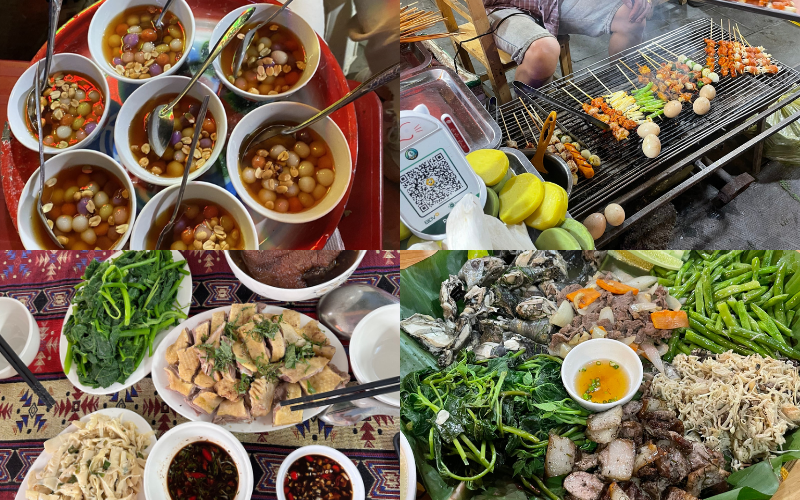
Food in Ha Giang
Some recommended restaurants to try:
– The Vương Restaurant (near the H’Mong King’s Palace)
– Hải Yến Restaurant (Đồng Văn)
In the heart of Hà Giang’s majestic mountains, every meal is more than just food — it is a story. Simple local ingredients, lovingly prepared by warm-hearted people, turn each dish into a memorable experience that reflects the soul of the highlands.
Ha Giang is a destination that captures travelers with its magnificent mountain scenery, unique culture, and authentic local lifestyle. The best time to visit is during the rice harvest season, from mid-September to late October, when terraced fields turn into a golden sea. However, each season offers its own charm: spring brings blooming buckwheat flowers, while summer is lush and green. Travelers should note that the rainy season (June–August) may cause landslides or floods, while winter (December–February) can be very cold and foggy, limiting visibility. Alternative activities are always available in case of weather disruptions.
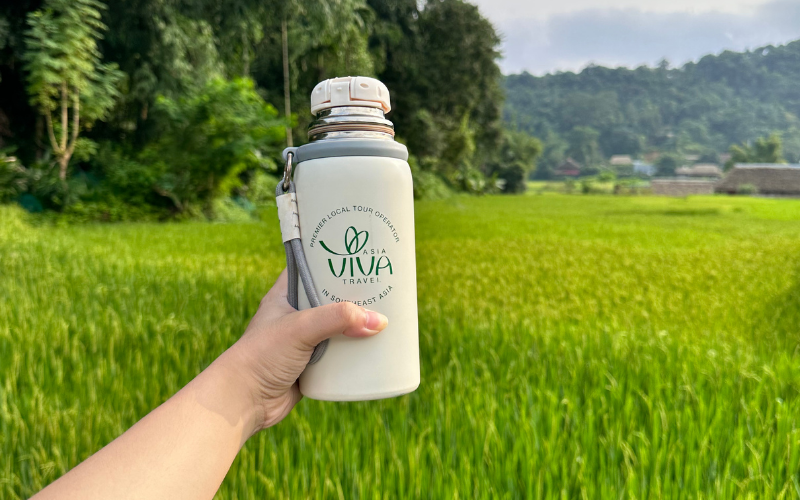
Ha Giang Uniques
The landscapes here are dominated by mountains, rivers, and a few small waterfalls. Trekking routes are mostly through hills and small forests rather than deep jungles. Hiring a local guide is highly recommended, as trails are not always well-marked, and guides can suggest alternative routes if needed.
Ha Giang is also home to 17 ethnic minority groups, making it one of the most culturally diverse provinces in Vietnam. Visitors can immerse themselves in daily activities such as raising livestock, harvesting tea, planting rice, or weaving fabric. Locals are exceptionally welcoming, ensuring that every experience feels genuine and meaningful.
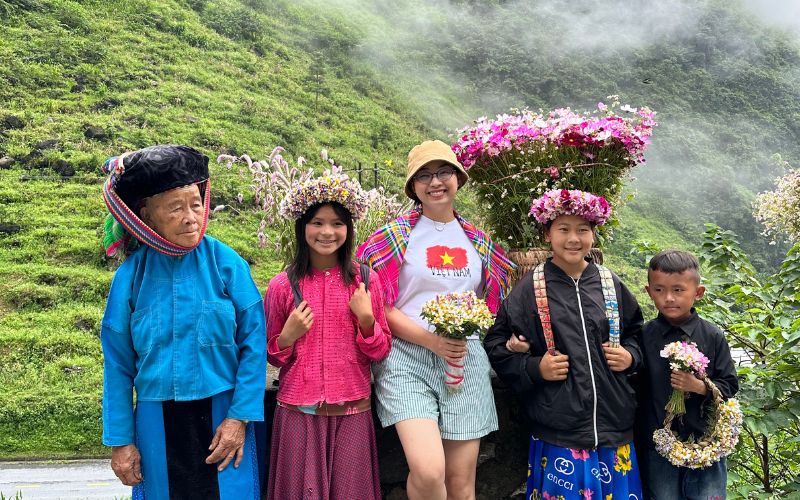
Ha Giang’s people
Travel in Ha Giang is not without its challenges. While main roads are generally in good condition, they are winding and include many mountain passes. Travelers prone to motion sickness should prepare accordingly. Distances between attractions can be long, requiring careful itinerary planning. The weather is generally cool, but it’s advisable to bring proper clothing for trekking and a light jacket for chilly evenings.
Service quality in remote areas can be uneven, so flexibility and patience are important. Visitors are also reminded to avoid giving money to children. If wishing to help, consider offering small gifts like snacks or school supplies instead.
Furthermore, except for the Dong Van old town area which is the center, most of the remaining attractions and accommodations are in the village. Depending on the location, there will be a grocery store (mini supermarket), but shopping as well as necessary items such as medicine should still be prepared in advance for convenience.
Ha Giang appeals to a wide range of travelers:
Whether the goal is to push physical limits or simply to relax and admire stunning scenery, Ha Giang has something to offer.
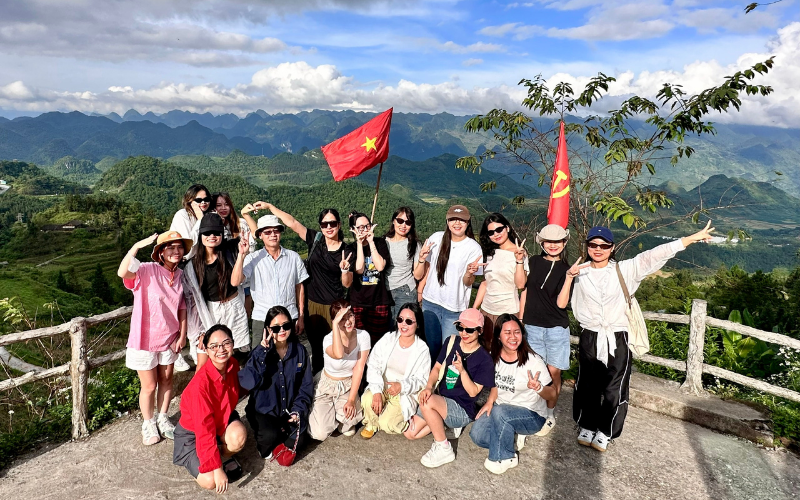
Best-Suited Traveler Profiles
The inspection trip to Ha Giang has reaffirmed the philosophy of “experience first – recommend later.” Every site visited, every service tested, and every activity engaged in has allowed Asia Viva Travel to refine and ensure the highest standards of safety, authenticity, and quality for future tours.
Ha Giang is more than just a destination – it is a living cultural tapestry interwoven with breathtaking landscapes and heartfelt human connections. The journey highlighted not only the province’s iconic attractions but also the nuances that travelers truly value: comfort, safety, and genuine local encounters.
Looking ahead, Asia Viva Travel is committed to making Ha Giang a must-include destination in upcoming tour products. Continuous inspections will be carried out to discover new services, expand diverse experiences, and create itineraries that adapt seamlessly to travelers’ needs.

 26/09/2025
26/09/2025Contents1. Chan Restaurant2. Hoa Vien Restaurant3. Phuoc Thanh Garden Restaurant4. Y Thao Garden Restaurant5. Les Jardins de la Carambole They say that the poetic beauty of Hué leaves an indelible impression on the heart of every visitor. The richness of its culture, cuisine, tourist attractions, and royal architecture has created unforgettable memories over time in […]

 26/09/2025
26/09/2025Contents1. Hoa Tuc Restaurant2. Indochine Junk3. Viet Village Restaurant4. Home Saigon Restaurant5. Ben Nay Restaurant Ho Chi Minh City, commonly known as Saigon, is one of the most dynamic and fascinating cities in Vietnam.Beyond its modern urban centers, Saigon captivates travelers with a rich and diverse culinary culture, born from the harmonious meeting of East […]

 26/09/2025
26/09/2025Contents1. Home Moc Restaurant2. Hanoi Food Culture3. Dương’ S Restaurant4. Blue Butterfly Restaurant5. Madam Hiền6. The East7. Ngũ Vị (5 Spices) 1. Home Moc Restaurant Add: 75 Nguyễn Đình Chiểu, Hanoi HOME Hanoi can accommodate up to 120 guests. It has private rooms and outdoor spaces. It is located 10 minutes from the Old Quarter. […]

 26/09/2025
26/09/2025Contents1. BAMBOO TAM COC RESTAURANTWhy a lot of visitors love it:2.LOTUS GARDEN RESTAURANT TAM COCWhat Makes It Special:3. SPICE GARDEN TAM COC4. Thắng Gương Restaurant5. Family Restaurant Tam Coc6. Hieu De Restaurant Ninh Binh is not only known for its stunning natural landscapes like Trang An, Tam Coc, and Bai Dinh Pagoda, but also for […]